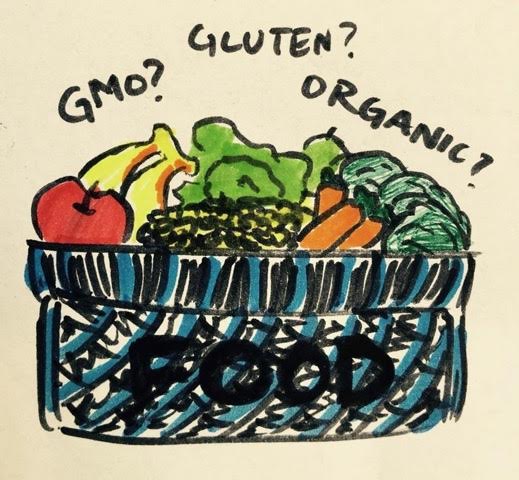The Preservative Paradigm: Why Labels on Food Do More Harm than Good

Art credits to Anu Korukonda!
April 20, 2016
Normally, the labels “Gluten-Free,” “Non-GMO,” and “Organic” have nutritious and wholesome connotations when it comes to picking up some groceries at the local supermarket. When one grabs a bottle of cooking oil at the grocery store or a bag of chips, one may perceive the classification of “All Natural” as a healthy one.
Like any product advertised in the supermarket, however, the label “All Natural” depends on one’s definition of the word “natural” as well as the sellers’ definition—and, in most cases, the product with the most labels does not guarantee that it is the safest choice.
Currently, there has been an increase in national recognition of health and well-being. Recent outbreaks of food scares have only heightened awareness of carbohydrates, fat, calories, and hydrogenated oils. In fact, a growing consumer demand for authentic food products has spurred a double-digit annual growth rate in the global organic food and beverage market. Labels such as “GMO-free” are being placed on food items all throughout supermarkets in America (“GMO” stands for genetically modified organisms).
This may seem appropriate to some consumers. After all, who doesn’t want to know that what they’re eating is straight from the earth? Jen Huang ‘18 agrees that “Everybody is health aware nowadays. Many people appreciate some sort of validation when they buy their food, and farmers are encouraged to be more considerate when growing food or raising animals.”
Unfortunately, in an attempt to increase consumer confidence in the authenticity of organics and to attract buyers with the image of a healthy lifestyle, labels on food products are usually misleading and merely a strategy to increase sales.
Typically, consumers incorrectly perceive a label as validation for a product’s health value. According to Elana Amsterdam, author of the health blog Elana’s Pantry, gluten-free foods actually do more harm than good. As a matter of fact, foods made without gluten are generally made with ingredients such as rice, corn, potatoes, sorghum, and tapioca, which are higher in carbohydrates and lower in protein and other nutrients than wheat flour. Moreover, while companies may advertise food as gluten-free, the food usually contains ingredients that are processed to make them free of gluten, with a prime example being potato starch. Gluten-free foods cheat the consumer out of the many health benefits of whole grains — such as wheat, barley and rye — and can seriously lack in critical nutrients such as fiber, iron, and calcium.
Another label that is overlooked is the classification of an “organic” product.
“The companies aren’t really explicit with what organic is,” comments Krista Webster ‘16.
Although organic foods may have the public reputation of being more healthful, the United States Department of Agriculture makes no claims that organic farming methods produce safer foods with higher nutritional value compared with conventionally produced foods. In truth, multiple studies reveal that food labeled as organic is nothing more than a marketing strategy.
In addition to the false claims that food labels normally possess, there are many terms behind the product that are subjective and can be interpreted differently. For example, “All Natural” does not have an official definition. It is difficult to tell if a packaged product is ever “natural” because many foods are processed in some way, which is why the United States Food and Drug Administration has not yet developed a definition of the term “natural” or its synonyms.
All foods have risks regardless of the label, and consumers play a large role in making the right choice. Catherine Luu ‘17 expresses, “Natural and organic can be misleading. I don’t think they should be on the product, because a lot of the natural and organic stuff you see at the supermarket isn’t at all, especially when it comes to meat.” Inevitably, people are going to try to market and sell foods in whatever way they can, and many consumers are swayed by the jargon-ridden packaging rather than the actual nutritional content.
Consumers will inevitably gravitate towards products with these labels because of the connotation associated with pure, wholesome food. Frankly, not only do the buyers have to pay attention to what they are eating, but the sellers also have to pay attention to what they are advertising. If society promotes a healthier lifestyle without preservatives and filler ingredients, there will be no need to label food as “All Natural” or “Organic.” Ultimately, it is one’s job to look past the labels and truly delve deeper into the meaning of the meal.
